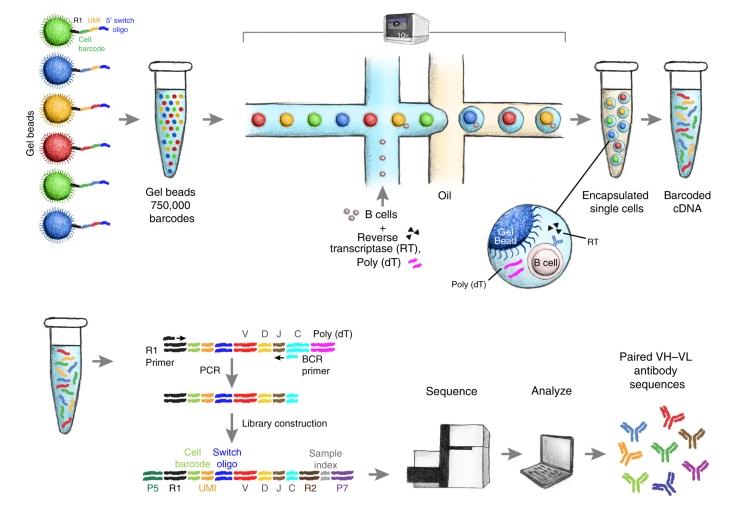What is Polyclonal Antibody Sequencing
Polyclonal antibody sequencing represents a de novo sequencing methodology grounded in mass spectrometry. Within the realm of biomedical research and medical science, this technique holds substantive practical utility. Polyclonal antibody sequencing enables the direct elucidation of antibody protein sequences derived from polyclonal antibodies (pAb), extracted from blood or alternative samples, thereby elucidating the amino acid sequence of monoclonal antibodies (mAb).
Why Choose Antibody Sequencing?
Polyclonal antibodies, as reagents widely employed in the scientific research arena, hold a crucial role in life sciences research. However, the batch-to-batch variations inherent to polyclonal antibodies result in issues of reproducibility, which can adversely impact the progress of studies. Therefore, despite their extensive application in life sciences, the challenges and limitations of polyclonal antibodies still need to be addressed.
At present, the standard method for polyclonal antibody production involves blending antibodies produced by multiple experimental animals (typically 2-20) to enhance reliability. Nonetheless, this approach usually yields antibodies of "general grade," and their specificity and sensitivity require improvement. In response to this issue, a novel solution emerged from the perspective of antibody sequencing. This method does two things: firstly, it conducts experiments for immunoprecipitation, Western Blot, ELISA, etc., on antibodies generated by each animal to identify and select the highest quality or most appropriate antibodies. Then, it undertakes polyclonal antibody sequencing and produces high-quality antibodies through recombinant protein expression. This approach not only reduces batch-to-batch variations but also improves the quality of antibody products.
Polyclonal antibody sequencing serves to discover high-affinity natural antibodies directly and efficiently, facilitating the production of recombinant antibodies with enhanced specificity and sensitivity.
Select Service
Current Polyclonal Antibody Sequencing Techniques and Limitations
At present, most research investigators primarily explore the constituents of antibodies in the blood through gene sequencing techniques. High-throughput sequencing technologies (NGS), for example, sequencing the mRNA of B-cell receptors (BCRs) in peripheral blood, is a common method. This BCR sequencing technique can effectively detect BCRs expanded post-targeting and yields extensive B cell receptor sequence information, thus indirectly revealing the antibody composition in immune responses. Before sequencing, flow cytometry or immunoprecipitation methods targeting specific antigens are typically employed to enrich and characterize B-cell sub-populations, allowing further filtration of useful sequence information.
Nonetheless, reliance on BCR sequencing to identify antibodies in the blood possesses certain limitations and deficits. Firstly, B cells are generated in the bone marrow and migrate to peripheral blood upon maturation, further distributing to the spleen and lymph nodes. However, BCR sequencing at present mainly captures B cells in the peripheral blood circulation, which represents only a minor part of the overall B cell population. In actuality, these antigen-stimulated antibody-producing B cells are more widely distributed in the spleen and lymph nodes, thus creating a detection blind spot. Secondly, without effective enrichment, the majority of B cells in the peripheral blood are merely natural B cells, lacking a direct link with the immune response, potentially confounding data analysis and accuracy of results. Lastly, within the receptors on the B cell surface, only a minor fraction eventually secretes into the serum, forming functionally effective antibodies.
While antibody detection in serum is important, relying solely on genomics information from B cell receptors is insufficient to accurately assess the status of serum antibodies. In truth, the functionally effective antibodies originate from a proteomic analysis, which captures complete and precise antibody information. Key to the advantages of the proteomic sequencing approach is that unlike cells, proteins are more challenging to obtain.
For instance, in monoclonal antibody production using hybridomas, if the cell lines suffer damage due to certain reasons, a small amount of antibody proteins are usually still preserved. Sequencing these proteins could possibly enable the "resurrection" of lost antibodies. Elsewhere, in immunized animals, antigen-specific antibodies exist massively in blood, whereas the cells producing these antibodies mainly reside in tissues like the spleen, making blood acquisition deed more convenient than cell retrieval. This advantage becomes even more pronounced when it comes to human sampling.
 Schematic of single B cell capture, library construction and sequencing.
Schematic of single B cell capture, library construction and sequencing.Applications of Polyclonal Antibody Sequencing
1) Biomarker application in disease diagnostics: In case of conditions such as cancer, vaccines, and autoimmune diseases, the immune system produces antibodies against specific antigens. Sequencing antibodies in circulating blood provides crucial information about the immune system, thereby facilitating diagnosis.
2) Development of antibody therapeutics: Polyclonal antibody sequencing allows researchers to discover new antibody drugs directly from immunized animals or human patients' blood. Particularly, discovering antibodies in human blood can reduce immunogenicity and enhance the safety and success of antibody therapeutic research.
3) Large-scale monoclonal antibody production: Polyclonal antibody sequencing can resolve the "reproducibility issue" in traditional antibody production technologies. By converting complex polyclonal antibody mixtures to monoclonal antibody forms and further conducting highly uniform recombinant expression, the scale of antibody production and development can be significantly expanded.
Antibody Sequencing Solution
The antibody characterization platform at Creative Proteomics relies on bioinformatics algorithms and a proteomics laboratory based on mass spectroscopy, integrating the latest research results in protein sequencing and protein chemistry. The sequencing workflow begins with polyclonal antibody protein samples or post-immunization blood samples, first conducting affinity purification and enzymatic digestion, followed by liquid chromatography tandem mass spectrometry (LC-MS/MS) determination. Then, we use bioinformatics software to analyze and process the obtained mass spectrometry data, with the final evaluation carried out by proteomics experts to ascertain full-length antibody sequences of heavy and light chain pairings for subsequent recombinant expression and testing.
Reference
- Goldstein L D, Chen Y J J, Wu J, et al. Massively parallel single-cell B-cell receptor sequencing enables rapid discovery of diverse antigen-reactive antibodies. Communications biology, 2019, 2(1): 1-10.














